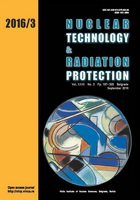
DETERMINATION OF NATURAL RADIOACTIVITY, 222Rn AND 220Rn EXHALATION RATES AND RADIATION HAZARDS OF FLY ASH AND FLY ASH BRICK USED IN BAOTOU, CHINA

Vol.
XXXI, No. 3, Pp. 197-305
September 2016
UDC 621.039+614.876:504.06
ISSN 1451-3994
Pages: 282-290
Authors: Yuxin Li, Xinwei Lu, and Xiaolan ZhangAbstract
Natural radioactivity levels, 222Rn and 220Rn exhalation rates and radiation hazards of fly ash and fly ash brick used in Baotou, China were determined. The activity concentrations of 226Ra, 232Th, and 40K in fly ash samples ranged from 38.81 to 93.73, 40.34 to 135.17, and 66.92 to 290.86 Bq/kg with an average of 76.52, 109.95, and 170.72 Bq/kg, respectively; while in fly ash brick samples, these radionuclides ranged from 42.43 to 71.60, 76.65 to 208.37, and 94.32 to 489.42 Bq/kg with an average of 53.83, 101.93, and 266.48 Bq/kg, respectively. The exhalation rates of 222Rn and 220Rn in all determined samples were in the range of 1.13-20.50 and 15.60-113.00 mBq/m2s, respectively. The calculated results of the radium equivalent activity, external hazard index, internal hazard index, indoor annual effective dose and outdoor annual effective dose indicated that fly ashes and fly ash bricks collected from some brick factories of Baotou would pose excessive radiation risks to inhabitants and that they are not suitable for use in building construction. The natural radioactivity level of fly ash and fly ash brick needs to be constantly monitored considering the radiation safety of the local residents.
Key words: natural radioactivity, radon exhalation rate, radiation hazard, fly ash, building material
FULL PAPER IN PDF FORMAT (660 KB)